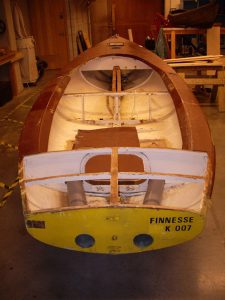 Finesse is the oldest surviving British registered Finn, possibly the oldest in the world.
Finesse is the oldest surviving British registered Finn, possibly the oldest in the world.
It was one of a number built for the 1952 Olympics (see early history of the class under Seawolf BAE0020) and numbers for the class were allocated internationally, with 9 going to Germany, 5 to France, 2 to Belgium, 2 to Austria, 1 to Denmark and 3 (numbers 3, 5, 7) to Great Britain. Finesse was Finn number 7 and was owned originally by Martin Beale, an important figure in British dinghy racing history. It was then owned by Richard Creagh-Osborne, one of the great British dinghy helmsmen, who gave it the name Finesse and sailed to first place in five Finn nationals. He also took part in several Finn Gold Cups (the Finn class’ world championship), though it is uncertain whether he used K7 for all of these. He reportedly believed that Finesse was faster than some of the later more sophisticated examples of the class that he owned.
With the screening of the first James Bond films K7 was later renumbered K007 by Creagh-Osborne. It also escorted the liner US United States up the Solent after her Blue Riband crossing.
The boat was later abandoned in a sailing club dinghy park for fifteen years during which time its condition deteriorated: it was subsequently donated to the museum where it underwent a programme of restoration.
Dimensions
Length 4.5m
Beam 1.51m
Draft (centreboard down) 0.89m


